Book Marketing Starter’s Guide: Insider Tips to Reach Your Target Audience
Learn book marketing tips about how to find your target audience, build a platform, and boost your book’s sales.
Authors often ask me about book marketing and the best way to go about it when they’re self-publishing their book. And it’s a great question, but the answer might seem complicated.
No one is going to market your book for you, unless you have a partnership with a traditional publisher or are using paid marketing. So you’ve got to think about the best way to use your time and your resources.
The rest of this article assumes that you’re doing it on your own or with a small team.
Here’s what you can expect in this post:
- Understanding Your Target Audience
- Amazon Tools (Free to Use)
- Developing a Long-Term Plan: Organic Book Marketing
- Amazon Ads
- Initial Steps for Long-Term Book Marketing
- Utilizing Email Marketing for Book Promotion
- Create a Valuable, Niche “Channel” for Book Marketing
- Leverage Book Bloggers and Podcasters: Organic Outreach
- Book Marketing: Paid Options
- When to Hire Someone to Do Your Book Marketing
- Additional Resources for Book Marketing
- Conclusion: Take Action and Reach Your Target Audience

Understanding Your Target Audience
The first task in marketing a book is to understand your target audience.
1. Create Your Avatar
We have created an avatar sheet that you can fill out if you want to think about who your target market is. I tell authors, as hard as it may be, to decide on the single individual that you’re writing for. Then you want to find where that individual is and market to them there.
Here’s a tool you can use toward this end: a fillable “Avatar” worksheet. I use this for business consulting, but it works just the same for “the business” of launching a book too.
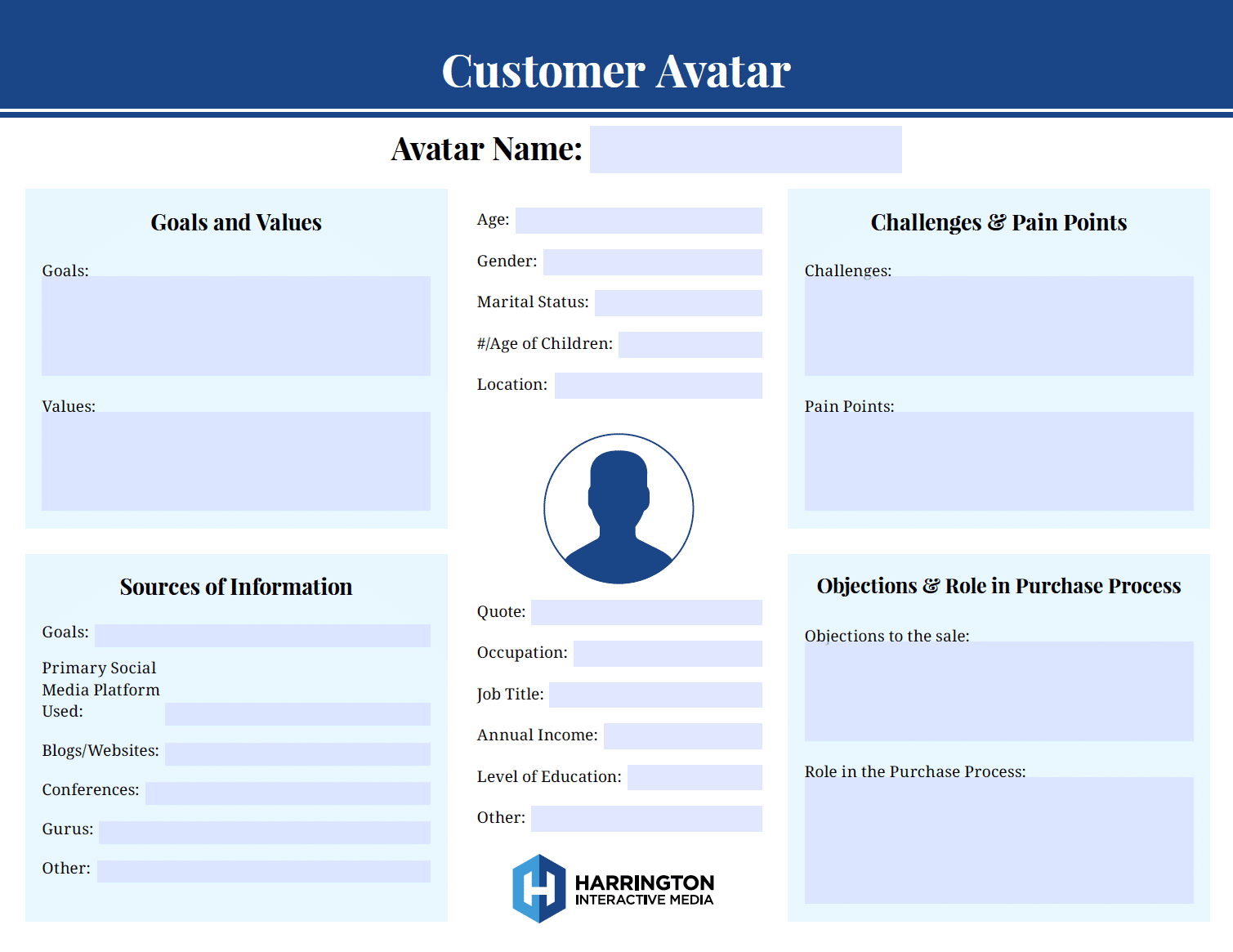
Stephen King, in his memoir On Writing, talks about the importance of writing for only one person.
Ideally you will write your book toward that one person, and that’s the goal with marketing, too. When it comes to marketing, you need to think, Okay, who is that person demographically? Who are they psychographically? And where do they go?
2. Consider a Demographic Description
You can arrive at a demographic description by thinking through these questions:
- Are they a pastor?
- A professor?
- A parent?
- A college student?
Consider all these kinds of things and more. Then land on one—just one!
3. Consider a Psychographic Description
The psychographic information can help you as well. You find out what your target audience’s needs and desires are. Ask: What are their felt needs? This is the best question you can ask about your audience.
Then think through: What are their struggles and challenges? What are their relevant characteristics that they all share? And what makes them different from other people?
Let’s say, for example, you want to market to Gen Z. You’ll want to consider getting on TikTok. That generation is not really on Facebook. Think about that kind of thing, as an example.
Amazon Tools (Free to Use)
There’s some low hanging fruit that I tell people to focus on if you really just want to get up to ground zero (not even taking ground, just getting to where things don’t look bad on Amazon).
The low-handing fruit is mainly utilizing Amazon’s built-in tools. Here’s an overview of the essential ones.
1. An Author Page
You’ll want to get an author page through Author Central first. This is where you fill out your bio, link to any books that you have previously written, and then upload a profile picture. It shouldn’t take you too long.
Doing this makes your profile look better, and you can link your profile to your books.
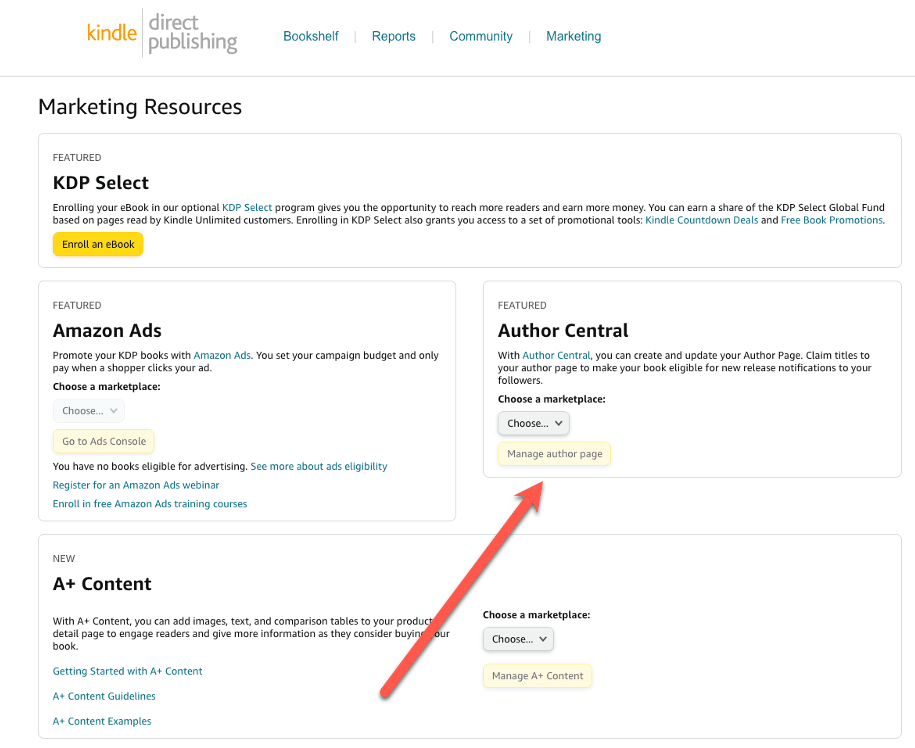
2. Amazon Affiliates
Another key task is to set up Amazon affiliate links so that you can track your marketing effort. This is free, just like your author page. With this set up, if you post an Amazon link on social media, send an email, or post a blog, as examples, you can actually track all of those clicks and see how things are converting on Amazon.
This is vital to measure what’s working and what’s not working.
3. KDP’s Built-In Marketing Tools
The third free-to-use Amazon tool is Kindle Direct Publishing’s built-in marketing tools. There’s a tool called “A+ Content,” which allows you to add offer comparisons and pictures to your product page.
Anyone can do that with their book! That means, you can totally do this with a little graphic design help.
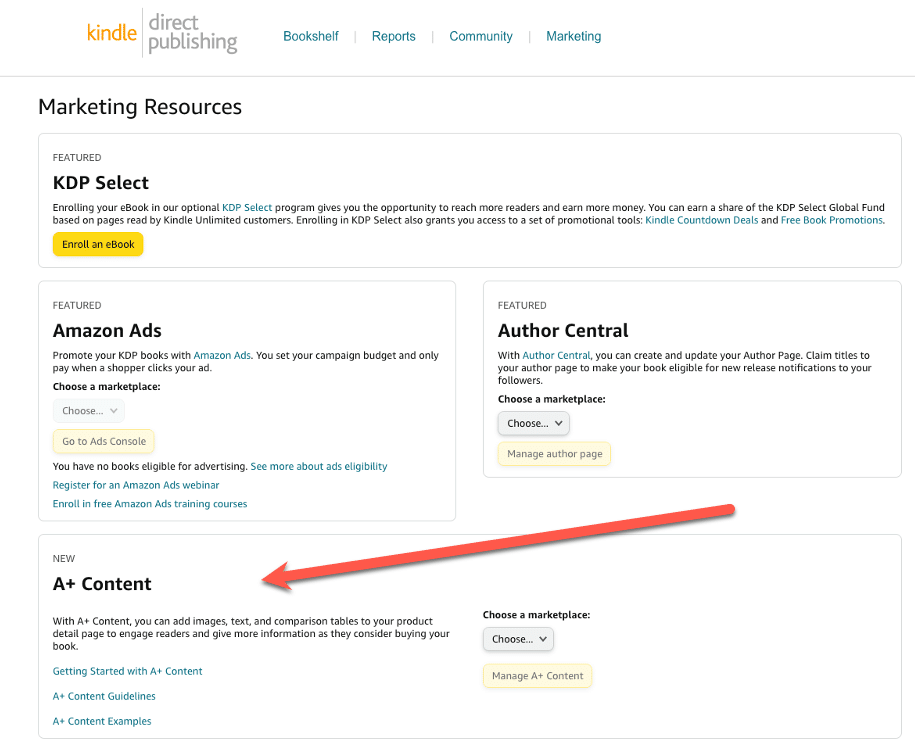
You log into KDP.amazon.com, click on marketing, and create your A+ Content.
This makes your book stand out more, and it can be simple if you have a graphic designer and some time on your hands.
Amazon Ads
You can also do Amazon ads, which is found in the same place. This is the best investment of your money, dollar for dollar, if you want to do paid ads. We’ll dive deeper into paid ads below.
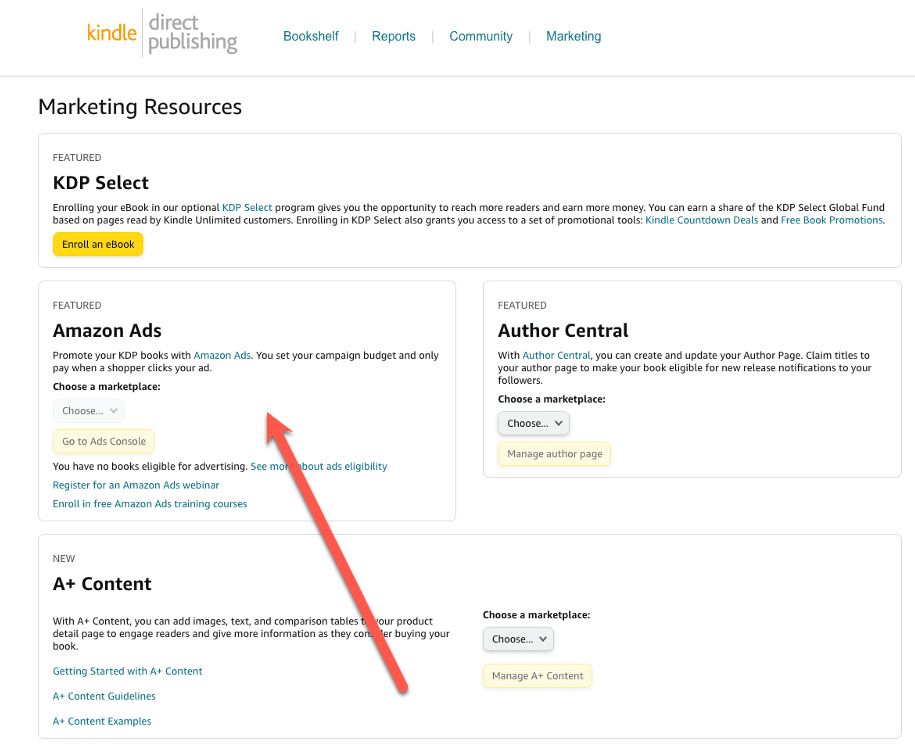
Developing a Long-Term Plan: Organic Book Marketing
Once you get that stuff set up — and let’s say you did some paid ads — there’s really not a whole lot else you can do that’s going to add true value unless you start to think about book marketing long-term.
If you’re just doing one book one time, I think a simple email to your friends and family and a few posts on social media is about all that you could do without jeopardizing your relationships.
Become your own best salesperson.
If you’re wanting to truly cultivate an audience and market your books long-term, however, do the following.
1. Think Long-Term
To take a long-term approach, think at least eighteen months in advance; but really, it’s best to think three years out. To build a true audience, it will likely take that long — at least, if you’re starting from scratch — whether it’s through email marketing, or social media.
2. Think on a Budget
If you don’t have any money to spend or if you have limited funding, then think about building an organic audience.
Maybe you’ll spend some money on a website so that you can build your audience that way. Maybe you’ll getting a nice professional headshot of yourself. Or maybe you’ll hire a designer for a quality cover design.
If you’re thinking long-term, spending your money on things that you’ll own is better than spending money on ads (which are temporary).
3. Think About Bringing Value
Authors, like anyone, can come across as “salesy,” but few books are sold with that kind of approach when you don’t have an audience. If you can think about bringing real value, though, in the way that you’re marketing, that’s going to take you far.
Consider giving things away for free and offer solid content. That’s offering value.
4. Think Audience-Building First — Not Sales First
Before you ever sell a book, if you’re thinking long-term, you should think, How can I build an audience? And the best way to build an audience is on property you own. I get this from Joe Pulizzi’s book Content Inc.
So get a website and get an email address where you actually, in a sense, own those assets and those contacts.
Initial Steps for Long-Term Book Marketing
So how do you actually start doing all this long-term marketing? Here are three key steps.
1. Garner Endorsements
I think the first step is to get endorsements from people who are well known, if you have the ability. That’s a great initial step for a specific book.
2. Start Email Marketing
Then it would be best to have direct contact with your audience through email marketing — and yes, email marketing is still 40 times more effective than social media marketing.
I get into more detail on email marketing below.
3. Build Your Audience
Next is building an audience on your blog or on a podcast / YouTube (or both). Neil Patel, an expert on content marketing, says that great content should be interesting, unique, informative, focused, and actionable.
Then social media is really at the bottom of the list in terms of value per post. But either way, you’re building an audience first, whatever platform you use.
Utilizing Email Marketing for Book Promotion
If email marketing is so effective (40x more than social media, as I noted above), how do you start building an email list?
When you want to create an email list, I suggest utilizing MailChimp. Even if it’s just 50 people, it’s worth it. (We’re not an affiliate, just a fan!)
You can send out an email once a week or once a month. Any less than once a month is probably not going to do much. Typically once a week is the pocket for regularity for most people.
Be consistent: Send it the same day every week, at the same time — or the same day every month.
Have singularity when you’re sending out emails. Instead of promoting 100 things — or even 10 things — focus on just one clear call to action in your email so that people will actually engage with your content.
Use text-only emails. I’ve heard of evidence and my experience shows the same, that text-only emails in most industries are as effective, if not more effective, than image-based emails — plus, they’re way easier to create. So use text-only emails and save yourself a bunch of headaches.
Create a Valuable, Niche “Channel” for Book Marketing
Next, create a valuable platform such as a niche blog, podcast, or YouTube channel.
You’ve got to find your niche, which is something that is at the intersection of your passion, your skills, and the audience’s felt needs.
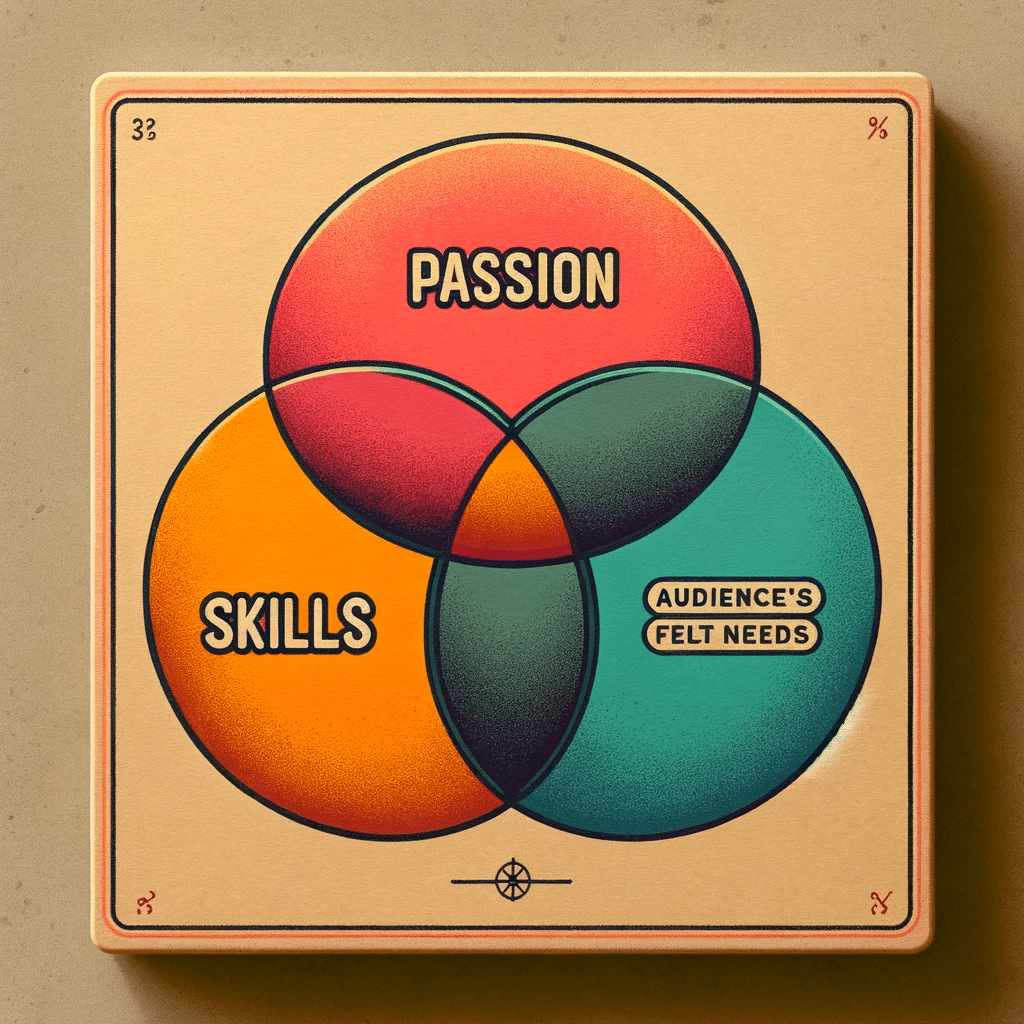
Joe Pulizzi talks in Content Inc. about finding your niche and then really pouring into that. So you want to find something that you’re passionate about because it’s going to be long term.
It needs to be something that you’re competent with, skilled at talking about, and experienced in — and people need to feel the need that you’re helping with.
On those blog, podcast, or YouTube platforms — just like with email marketing — post consistently. Once a week is a great rhythm. If it’s super high production or if you don’t have the bandwidth, then once a month works as well.
Then when you’re doing that, bring value every time. Focus on bringing value, and only sell directly 10-20% of the time. You can do indirect selling more often than that, but don’t be a salesperson with every post. It’s content marketing that you’re really focusing on.
Leverage Book Bloggers and Podcasters: Organic Outreach
Then, once you’ve got your platform, think about other people’s platforms. This is a great way to network and — in a non-salesy way — to let people know that you have a platform too.
Get on other people’s blogs, podcasts, or YouTube channels. Think about people you know who have those platforms that you can do a guest interview or a post on. Then potentially, think about people who know people who have those platforms who might want to connect you.
Try to get on those other blogs. Maybe you do this quarterly, or you’re on their podcast once or twice a year, or on their YouTube channel. That way, people in a different audience can find out about you.
Book Marketing: Paid Options
There are some good paid options for book marketing.
1. Use Amazon’s Paid Ads
So I mentioned above Amazon’s paid ads. I did an experiment a few years ago where we spent the same amount of money on Facebook as we did on Amazon’s KDP direct paid ads. Facebook had terrible results. But we had a decent return on investment through KDP.
So go on KDP’s marketing page. You can market to different audiences, with different keywords, and different countries. You can do all sorts of stuff.
Optimize your ads, and that’s the best way to spend money on paid ads for books that I know of.
2. Reach Out to Influencers for Paid Placements: Blogs, Podcasts, and Social Media Profiles
Then — similar to organic reach with other people’s blogs, podcasts, and YouTube channels — reach out to influencers who you don’t know who charge money for you to post or be interviewed.
That’s really just the matter of doing some research upfront. How much money do you have to spend, and how much do these people charge? It can be just as good as paid ads, but it’s totally dependent on the niche. You just got to think through: Where is your audience?
3. Do Paid Ads on Google
Google has generated $244 billion in Google Ad revenue in a recent year. The average marketer gains $6+ in revenue for every $1 they spend on ads. That’s huge! You have to learn how to make effective ads, but if you have marketing help, it’s likely they can make your book sell through Google Ads.
When to Hire Someone to Do Your Book Marketing
Another option is to hire a professional to market your book.
How do you know when you want to hire someone to do your marketing?
- When you have more money than time
- When you have a book that you need to get out fast
- When you want to make a big impact
You have to have a bigger budget for this option. Maybe you’re a well-known author, or maybe it’s the only book you’re ever going to do and you just want to make a big wave.
You can hire someone to do PR for your book. PR gets you placements on media outlets. So if you don’t want to do the outreach for getting places and you want it to be organic, you can invest money not in paid ads, but in a PR rep who has relationships with platforms in your niche.
Then you can also hire someone who’s a professional digital marketer to actually do your paid ads for you. They can create the graphics, the content, and all that.
There are people who do both PR and paid ads, but I would hire someone different for PR than for your direct paid digital ads.
Additional Resources for Book Marketing
If you want to dive deeper into book marketing — or into how to market yourself in general — here are some great resources that I recommend. These are content marketers and resources that I respect.
Additionally, an article that helped me out early on in my content marketing experience was: “89+ Book Marketing Ideas That Will Change Your Life”.
Conclusion: Take Action and Reach Your Target Audience
The main thing is you need to think through who your target audience is. Cultivate an audience long-term. Then, offer value to that audience so that when you do launch a book, they know, like, and trust you — which is the goal, according to Joe Pulizzi’s constant refrain.
Instead of trying to knock their door down to sell something to them, you want to set yourself up so that when you have something to sell, they’re already into you. Then, they’re going to want to buy whatever it is you sell.
This stuff works. It just takes time, and it takes investment. You can do it.
These are some basic methods for book marketing. Obviously, there are a lot of other niche ways, but these should get you on a good path.
While we don’t currently offer marketing services, we do offer production services — everything from the idea of a book; to author coaching; to editing, design, and printing — to help you create a beautiful book worth marketing. If you want to talk about those services, schedule a 20-minute intro call with our team here.
Or if you’re further in the process and you’re ready to get to work on your book, you can go ahead and get a quote. Once you submit your quote request, we’ll schedule a call with you to go over it and determine a potential fit.